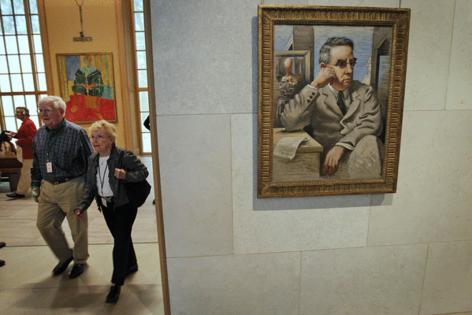Billionaire art lover Albert Barnes was brilliant in business. He was also 'emotionally, socially incredibly stupid'
Published in Books News
PHILADELPHIA -- Albert C. Barnes, founder of the Barnes Foundation, was too large a character to be restrained by mortality. He and his collection have been the subject of a documentary and books, and the terms of the indenture guiding the fate of his multibillion-dollar art collection, now housed on the Benjamin Franklin Parkway, has spun off numerous legal cases since his death in 1951.
Art critic Blake Gopnik spent hundreds of hours immersed in Barnes’ letters, writings, and other materials, and has produced a 403-page biography, "The Maverick’s Museum: Albert Barnes and His American Dream," released recently on the 100th anniversary of the official dedication ceremony for the Barnes. Here we speak with him about Barnes — one of the most pugnacious and idiosyncratic figures Philadelphia has ever produced.
The conversation has been edited for clarity and brevity.
What does this book tell us that we didn’t know already?
The thing that attracted me to writing this book, I guess more than anything else, was his unbelievable archive. I wrote a giant thousand-page biography of Andy Warhol, and he kept almost every scrap of paper you could imagine. [Barnes] kept even more than Warhol. He kept the letters he sent, he kept the letters he received, often in triplicate. He kept drafts of his writings. I’m not sure that we really understood the contradictions that are at the heart of Albert Barnes, the fact that he could be just an incredibly smart man and a man who was emotionally, socially incredibly stupid, a man who could be incredibly generous and just absurdly vituperative, and I think having access to that vast archive really makes a big difference in our ability to understand him as a person.
What are some of the things that surprised you about him?
I knew about his support for Black culture and Black society, but I didn’t realize just how deep it ran. He’s a complicated figure in his relationship with Black America, but for someone working in the 1920s, the level of his support, at least rhetorical polemical support, was really extraordinary. It’s hard to remember just how racist America and especially Philadelphia was when he was coming of age, certainly, after Reconstruction, but then well into the 20th century. So for anyone to say the things that he did in support of Black Americans was really quite extraordinary.
What attracted Barnes to art in the first place?
I think one of the most important things to understanding him is his rise from less than nothing. His rise from this neighborhood called the Neck, which Philadelphians don’t seem to have any sort of collective memory of any more, but it was really most of what we now think of as South Philly and was a kind of a swamp and one of the worst slums in all of America. And the fact that he rose from that to be a person of real substance, a scientist of substance, and then a culture vulture of substance, mattered a great deal to him.
That ownership of culture really matters a great deal, and then collecting modern art, what then counted as radical, was part of his general hatred for the elites. It’s part of his attack on anything that stood for business as usual in American culture.
The Barnes experience came with theories about how to look at art, how to think about art. As an art critic, what do you think about these theories?
They were cutting edge when he was advancing them. One of the things I hope my book does is point out how important he is in the history of what’s called formalist art thought, formalist art criticism. Paying attention only to things like line and shape and color and ignoring subject matter, that was the dominant mode in American art criticism right until my childhood. That’s how I was raised as an art looker, and his role in that is really important. The Museum of Modern Art in New York is seen as the repository of that tradition, but I think he had a huge influence on its original director, Alfred Barr, who was less of a formalist than Barnes was when he first encountered Barnes’ ideas.
You write about a visit you made to the Barnes on the Parkway, and you say, ‘The ghosts of Barnes and de Mazia barely hover.’ What did you mean by that?
Barnes and his lieutenant, [Violette] de Mazia, are everywhere in the sense that the presentation of the work is virtually unchanged from his death. But the big difference is now you can do whatever you want with it. There’s no one telling you how to look at the work. You can wander through and look for pictures of dogs. You can go and look for the color red. You can look at racial relationships and his views on the very important African art collection that he amassed. You can do whatever you want, and I believe that that’s what art wants from you. And that’s what Barnes I don’t think got right in his own art theories. He saw only one way of looking at art.
It’s been more than a dozen years since the Barnes moved to the Parkway from its original setting. Do you think it was a good thing? Do you think it was right?
I’m not a big fan of paying too much attention to what very dead rich people want to do with their art. The art now belongs to the people of America and of the world. All art that’s any good, maybe all art in general, always belongs to the people of the world. Rich people just have it for a little while in their homes. It doesn’t really belong to them. And now that wonderful museum on the Parkway lets everyone use this art, and that’s what art is for.
Was anything lost in it not being the authentic experience it once was? What the Barnes was in its previous incarnation was something special and quirky.
It’s still pretty quirky. You go into the Barnes as it stands today, and it is not your normal museum experience. Those walls look very different from the way they look anywhere else. In fact, it wasn’t founded as a museum. It was founded as an educational institution. You can’t really teach a curriculum from 1925 anymore. It has all sorts of problems.
So what the institution was in 1925 shouldn’t have been saved. That’s true of Harvard and Oxford and every single educational institution in the world. You would not want them to go back to what they were in 1925. Those were institutions that suited their era, and they need to be different today, as does the Barnes. But the art is still there, and it’s some of the greatest art in the entire world.
©2025 The Philadelphia Inquirer, LLC. Visit at inquirer.com. Distributed by Tribune Content Agency, LLC.













Comments